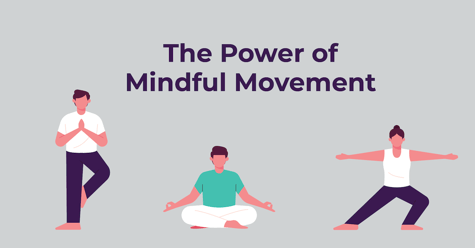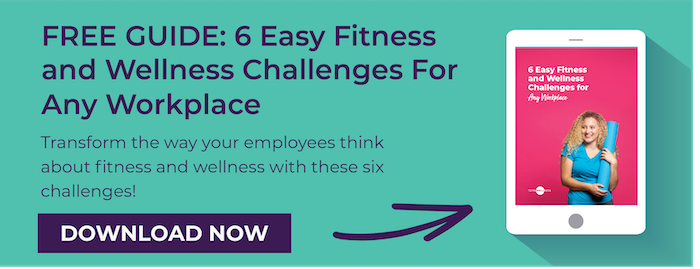 In a world filled with constant distractions and overwhelming news, attaining a sense of inner peace and tranquility can often seem like an impossible task. But imagine if finding that desired serenity could be as simple as moving with intention and awareness.
In a world filled with constant distractions and overwhelming news, attaining a sense of inner peace and tranquility can often seem like an impossible task. But imagine if finding that desired serenity could be as simple as moving with intention and awareness.
With increasing demands on our time and attention, many are turning to an ancient remedy: the fusion of mindfulness and physical activity.
Engaging in mind-body movement provides a unique benefit: while you focus on improving your physical well-being, you also nurture and nourish your mind. As you sculpt and strengthen your muscles, your mind finds solace and serenity. Whether it's the core-crunching moves of Pilates, the graceful flow of tai chi, the energy channeling of qigong, or the soulful stretches of yoga, these practices are growing in popularity.
If you're ready to explore ways to infuse mindfulness into your exercise routine, read on to discover the transformative power of these practices.
The Mind-Body Connection
Science continually reinforces the connection between mental and physical health. Chronic stress, for instance, not only erodes emotional well-being but can also lead to tangible physiological problems. Engaging in mindful physical practices serves dual purposes: building strength and resilience while also alleviating mental burdens.
Traditional workouts focus predominantly on physical outcomes — muscle strength, flexibility, or endurance. While these are undoubtedly vital, activities like yoga and tai chi add an invaluable layer: awareness. This mindfulness fosters a deeper connection between movements and mental states, allowing practitioners to not just "do" an exercise but "experience" it.
In the United States, yoga, Pilates, qigong, and tai chi have emerged as some of the most popular mind-body exercises. These practices are not only therapies that combine movement, breathing exercises, and meditation, but they also have the power to enhance your overall physical and mental well-being, foster self-awareness, and promote spiritual growth.
A Peek Into Each Practice
Each of these exercises offers a unique blend of physical benefits and soulful enrichment.
Yoga- Postures (Asanas): These range from simple stretches to complex positions. Each asana is designed to target specific parts of the body, enhancing flexibility and strength.
- Breathing (Pranayama): An integral component, pranayama techniques help regulate the flow of prana or life force throughout the body. They aid in calming the mind and improving respiratory efficiency.
- Meditation (Dhyana): This promotes mindfulness, concentration, and clarity, guiding individuals toward self-realization and inner peace.
Related: Take a moment to explore this beginning yoga video.
Tai Chi
Tai chi, often described as "meditation in motion," embodies the Chinese principle of Yin and Yang, the opposing forces within the body. Despite its slow and gentle nature, tai chi effectively targets important aspects of fitness, such as muscle strength, flexibility, balance, and, to a lesser extent, aerobic conditioning.
- Flowing Movements: Unlike traditional exercise forms, tai chi emphasizes fluidity. The exercises comprise a series of motions named for animal actions, like "white crane spreads its wings," or martial arts moves such as "box both ears."
- Characteristics: These movements stand out due to their circular, relaxed nature. They avoid muscle tension, extreme joint bending, or stretching of connective tissues. Instead, the focus is on natural, deep breathing and tuning into one's bodily sensations.
- Adaptability: Tai Chi's gentle approach ensures it's suitable for everyone, from fitness enthusiasts to those with mobility issues or in post-operative care. It provides an oasis of calm and balance, irrespective of physical condition.
Related: Discover the transformative power of this quick tai chi routine that only takes 5 minutes a day.
Qigong
Rooted in ancient Chinese medicine, martial arts, and philosophy, qigong is a practice centered around harnessing and circulating Qi, the life energy.
- Forms and Movements: qigong has diverse forms, some mimicking the movements of animals or nature. Each form is designed to guide the Qi in specific patterns around the body.
- Breathing and Meditation: Deep, diaphragmatic breathing in tandem with meditation is crucial. This helps in the detoxification, nourishment, and balance of the body.
- Healing and Wellness: Beyond just a physical regimen, qigong is often used as a therapeutic tool, addressing various ailments by restoring the balance and flow of Qi.
Related: Embark on your qigong journey with this invigorating daily routine.
Pilates
Pilates, a more contemporary addition to the world of mindful movement, seamlessly integrates the principles of core strength, body alignment, and graceful movement. Developed in the early 20th century by Joseph Pilates, this system was initially designed to rehabilitate injured soldiers during World War I. Today, it remains a holistic fitness system that is beloved by many for its wide range of benefits.
-
Core-Centric: One of the foundational pillars of Pilates is the emphasis on core strength. Often referred to as the "powerhouse," the core muscles include the deep abdominal muscles, obliques, lower back, and pelvic floor.
-
Breath and Concentration: Similar to the other practices we've explored, Pilates emphasizes the importance of focused breathing. Each movement is coordinated with a specific breathing pattern, optimizing oxygen flow and facilitating muscle activation. This synchronicity of breath and movement fosters mindfulness and enhances the connection between the mind and body.
Related: Take a moment to explore full body Pilates workout for beginners.
Beginner’s Guide to Mindful Exercise
For those looking to integrate mindfulness into their physical routines, the journey need not be daunting. Here are some steps to consider:
Start Slow
Just as one doesn't run a marathon without training, plunging headfirst into a fully mindful practice can be overwhelming. Begin with short sessions, gradually expanding as comfort grows.
Find Your Fit
Not all practices will resonate with everyone. Some may gravitate towards the structured poses of yoga, while others might prefer the fluidity of tai chi. Experiment to discover what aligns best with your temperament.
Create a Conducive Environment
Environment plays a pivotal role in mindfulness. Choose a quiet space, perhaps adorned with soothing music or scents, to create a sanctuary for your practice.
Seek Guidance
While self-learning has its merits, the nuances of these practices can be best understood under the guidance of a seasoned instructor. They can provide not just technical insights but also foster a deeper appreciation for the philosophy underlying the movements.
Zen and the Art of Fitness
The resurgence of interest in yoga, tai chi, Pilates, and qigong is not just a testament to their timeless appeal but also a reflection of a broader shift in how health is perceived and pursued. These practices have gained popularity as people seek holistic approaches to their well-being, recognizing that true health encompasses not only physical fitness but also mental and emotional balance.
In our fast-paced and chaotic world, more and more individuals are turning to these mind-body exercises as a means of finding solace, inner peace, and a connection to something greater than themselves. They offer a respite from the constant demands and distractions of daily life, inviting practitioners to slow down, breathe deeply, and tune in to the present moment. It is a testament to the human desire for peace, tranquility, and a sense of purpose. By incorporating these practices into our daily routines, we can not only improve our physical fitness but also cultivate a deeper sense of well-being and fulfillment.



